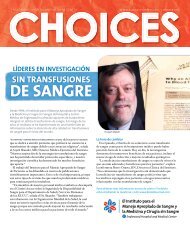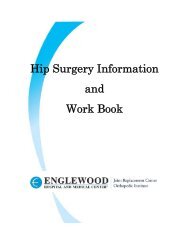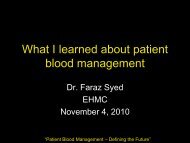Healthy You: Spring 2011 - Englewood Hospital and Medical Center
Healthy You: Spring 2011 - Englewood Hospital and Medical Center
Healthy You: Spring 2011 - Englewood Hospital and Medical Center
Create successful ePaper yourself
Turn your PDF publications into a flip-book with our unique Google optimized e-Paper software.
the healthcare magazine for englewood hospital <strong>and</strong> medical center <strong>Spring</strong> <strong>2011</strong><br />
<strong>Healthy</strong> <strong>You</strong><br />
Advanced<br />
Techniques in<br />
Pediatrics<br />
&<br />
One Patient’s<br />
Renewed Outlook<br />
on Life<br />
Comprehensive<br />
Cancer<br />
Services<br />
for Patients<br />
englewoodhospital.com
Walter B., post-surgery, with exercise<br />
physiologists Peter Toto (left) <strong>and</strong><br />
Anthony Avecilla (right)<br />
What He’s Gained<br />
Outweighs What He’s Lost<br />
Walter B., a 39-year-old resident of West New York, had come to terms with his obesity some time ago.<br />
However, his mother worried about her son. She had already lost her three other sons <strong>and</strong> did not want to<br />
lose Walter to a battle against obesity.<br />
In July 2009, while visiting a friend, Walter did not recognize<br />
his friend’s aunt. She had undergone bariatric surgery <strong>and</strong> had lost<br />
a significant amount of weight. Walter was amazed by her success<br />
with the procedure.<br />
The following week, an unmarked envelope arrived in Walter’s<br />
mailbox. Inside was information about bariatric surgery at<br />
<strong>Englewood</strong> <strong>Hospital</strong> <strong>and</strong> <strong>Medical</strong> <strong>Center</strong>. He took the delivery as<br />
a sign that he needed to confront his obesity. He decided to learn<br />
more about the surgical options that would change his life <strong>and</strong><br />
ultimately improve his health.<br />
Turning to a Specialized Team<br />
On April 13, 2010, Walter was admitted to <strong>Englewood</strong> <strong>Hospital</strong><br />
for bariatric surgery. He weighed 543 pounds.<br />
Under the care of Ibrahim M. Ibrahim, MD, FACS, FASMBS,<br />
BSCOE, Director of Minimally Invasive Surgery <strong>and</strong> Bariatric<br />
Surgery at <strong>Englewood</strong> <strong>Hospital</strong>,<br />
<strong>and</strong> his associate, Jeffrey<br />
Strain, MD, FACS, FASMBS,<br />
BSCOE, bariatric surgeon,<br />
Walter underwent a weight-loss<br />
procedure called laparoscopic<br />
sleeve gastrectomy. This surgery<br />
removes a portion of the stomach,<br />
restricting the amount of food it<br />
Ibrahim M. Ibrahim, (left) MD, FACS, FASMBS,<br />
BSCOE, Director of Minimally Invasive Surgery<br />
<strong>and</strong> Bariatric Surgery at <strong>Englewood</strong> <strong>Hospital</strong>,<br />
<strong>and</strong> his associate, Jeffrey Strain, MD, FACS,<br />
FASMBS, BSCOE, bariatric surgeon<br />
can hold. Less than one year later,<br />
Walter weighs 255 pounds. He has<br />
lost four shirt sizes <strong>and</strong> 22 waist<br />
sizes—<strong>and</strong> gained self-respect<br />
<strong>and</strong> confidence.<br />
Walter B., before weight-loss<br />
surgery at 543 pounds<br />
“Successful weight loss <strong>and</strong> health maintenance are best achieved<br />
with a comprehensive team approach,” says Dr. Ibrahim. “The<br />
surgeons work with the bariatric patient advocate, pre-admission<br />
testing experts, psychiatrists, social workers, dietitians, nurses, <strong>and</strong><br />
exercise physiologists. Each plays an integral part in the outcomes for<br />
our patients. But what made Walter’s surgery a success was his desire<br />
to be healthy <strong>and</strong> fit.”<br />
Walter still exercises regularly at the Bariatric Health <strong>and</strong> Fitness<br />
Program, located within the Cardiac Rehabilitation Fitness <strong>Center</strong><br />
at <strong>Englewood</strong> <strong>Hospital</strong>. And, in case you are still wondering who put<br />
the mysterious envelope in Walter’s mailbox… it was his mother’s<br />
best friend.<br />
For information about our free weight-loss surgery seminars,<br />
visit BestBariatricDocs.com. For a referral to a weight-loss<br />
surgeon at <strong>Englewood</strong> <strong>Hospital</strong>’s Bariatric <strong>Center</strong> of Excellence ® ,<br />
call 1-866-980-EHMC (3462).<br />
Overcoming Obstacles<br />
Following Walter B.’s weight-loss surgery, he began rehabilitation at<br />
<strong>Englewood</strong> <strong>Hospital</strong> <strong>and</strong> <strong>Medical</strong> <strong>Center</strong> with exercise physiologist<br />
Peter Toto.<br />
“We began with exercise three days a week, but soon Walter was asking<br />
to do more,” says Mr. Toto. “No one could hold Walter back—he truly is<br />
a success story because of his attitude <strong>and</strong> will to change his life. He<br />
lights up the <strong>Center</strong> when he is here. He knows everyone’s name <strong>and</strong><br />
shows mutual respect for everyone. Walter is ‘hungry to succeed.’”<br />
2 ¦ <strong>Healthy</strong> <strong>You</strong> <strong>Spring</strong> <strong>2011</strong>
Uterine Fibroids:<br />
Know <strong>You</strong>r<br />
Facts <strong>and</strong> Options<br />
According to the Society of Interventional Radiology, up to 40 percent of women ages 35 <strong>and</strong> older may develop a<br />
uterine fibroid of a significant size. While these noncancerous tumors are often asymptomatic, they can be the root<br />
of an array of troublesome problems, from abdominal pressure <strong>and</strong> pelvic pain to heavy bleeding.<br />
Often discovered during routine pelvic exams, uterine fibroids<br />
can vary in size—ranging from pea-sized to the circumference of a<br />
melon. Their cause remains largely unknown despite being studied<br />
by scientists <strong>and</strong> clinicians.<br />
“The origin of uterine fibroids is not understood, but medical<br />
research has associated the condition with genetic predisposition<br />
<strong>and</strong> high hormone levels, specifically estrogen,” says Phillip<br />
Bahramipour, MD, Director of Interventional Radiology at<br />
<strong>Englewood</strong> <strong>Hospital</strong> <strong>and</strong> <strong>Medical</strong> <strong>Center</strong>.<br />
Expert Care When <strong>You</strong> Need It<br />
While fibroids are a very common condition, the good news is<br />
that only about 25 percent of women have fibroids that can cause<br />
symptoms. But those who suffer can take comfort in the fact that a<br />
variety of medical <strong>and</strong> surgical treatments abound.<br />
Over-the-counter drugs, such as ibuprofen, may ease occasional or<br />
mild pelvic pain. However, women who experience frequent or more<br />
severe symptoms may require prescription medication <strong>and</strong> close<br />
physician monitoring.<br />
Hormone therapy may help shrink fibroids by preventing the<br />
pituitary gl<strong>and</strong> from overproducing estrogen. Birth control pills are<br />
also often prescribed for women with uterine fibroids, to control<br />
blood flow <strong>and</strong> relieve pelvic pain.<br />
In cases of severe symptoms or advanced tumor size, surgery<br />
may be necessary to treat uterine fibroids. Surgical options<br />
include uterine fibroid embolization (see inset below) in addition<br />
to the following:<br />
• Myomectomy—This is the best surgery for patients who want<br />
to have children. The doctor removes the fibroids without<br />
removing healthy tissue in the uterus.<br />
• Endometrial ablation—To manage heavy bleeding, the uterine<br />
lining is destroyed or removed.<br />
• Hysterectomy—This surgical procedure removes the uterus<br />
<strong>and</strong> is generally performed when a woman experiences excessive<br />
bleeding or has very large uterine fibroids.<br />
Could <strong>You</strong> Have Uterine Fibroids<br />
The most common symptoms of uterine fibroids include:<br />
• A need for frequent urination<br />
• Full feeling in the lower abdomen<br />
• Heavy periods<br />
• Increase in waist size<br />
• Irregular bleeding between periods<br />
• Pain during intercourse<br />
Only a physician can diagnose uterine fibroids. For a referral to an<br />
<strong>Englewood</strong> <strong>Hospital</strong> gynecologist, call 1-866-980-EHMC (3462) or visit<br />
<strong>Englewood</strong><strong>Hospital</strong>.com.<br />
Phillip Bahramipour, MD,<br />
Director of Interventional Radiology<br />
Minimally Invasive Fibroid Treatment<br />
Uterine fibroid embolization is a surgical option that deprives the fibroids of<br />
blood, causing them to shrink. <strong>Englewood</strong> <strong>Hospital</strong> <strong>and</strong> <strong>Medical</strong> <strong>Center</strong> offers<br />
this advanced procedure. The minimally invasive surgery typically produces no<br />
side effects <strong>and</strong> alleviates symptoms in 90 percent of patients.<br />
“This procedure is designed to preserve the uterus,” says Phillip<br />
Bahramipour, MD, Director of Interventional Radiology at <strong>Englewood</strong> <strong>Hospital</strong>.<br />
“Over time, the fibroids shrink, <strong>and</strong> patients’ symptoms are relieved.”<br />
To learn more about uterine fibroid embolization, call <strong>Englewood</strong><br />
<strong>Hospital</strong>’s Department of Interventional Radiology at (201) 894-3480.<br />
<strong>Spring</strong> <strong>2011</strong> <strong>Healthy</strong> <strong>You</strong> ¦ 3
Treating Tough Cancers with an<br />
Expert Team Approach<br />
Cancers of the bile ducts,<br />
liver, <strong>and</strong> pancreas<br />
have been historically<br />
difficult to treat because<br />
of their location in the<br />
human body <strong>and</strong> lack<br />
of symptoms until the<br />
disease is advanced.<br />
Experienced physicians<br />
at the new Pancreas,<br />
Biliary, <strong>and</strong> Liver <strong>Center</strong><br />
at <strong>Englewood</strong> <strong>Hospital</strong><br />
<strong>and</strong> <strong>Medical</strong> <strong>Center</strong><br />
combine their expertise<br />
to maximize treatment of<br />
these rare cancers.<br />
4 ¦ <strong>Healthy</strong> <strong>You</strong> <strong>Spring</strong> <strong>2011</strong><br />
Cancers of the pancreas, liver, <strong>and</strong> bile<br />
ducts—also known as hepatopancreaticobiliary<br />
cancer—are in the top 10 leading causes of<br />
cancer deaths in the United States. Because<br />
symptoms are vague or nonexistent in the early<br />
stages of the disease, these cancers are most<br />
often found too late for curative surgery.<br />
Herbert Dardik, MD,<br />
Chief of Surgery <strong>and</strong> Vascular Surgery<br />
Michael Schleider, MD,<br />
Chief of Hematology <strong>and</strong> Oncology<br />
“Nationally recognized surgeons have<br />
joined <strong>Englewood</strong> <strong>Hospital</strong>’s large number<br />
of experienced physicians to provide leadingedge,<br />
compassionate care through the<br />
Pancreas, Biliary, <strong>and</strong> Liver <strong>Center</strong>,” says<br />
Herbert Dardik, MD, Chief of Surgery <strong>and</strong><br />
Vascular Surgery at <strong>Englewood</strong> <strong>Hospital</strong>.<br />
Barry M. Zingler, MD,<br />
Chief of Gastroenterology
“Our entire team works together to maximize the long-term<br />
survival of our patients, from accurate diagnosis using the latest<br />
technology available, through the acute phase, <strong>and</strong> into the<br />
chronic phase of the disease.”<br />
Diagnosing the Problem<br />
Hepatopancreaticobiliary cancer can be found at earlier stages<br />
when physicians are screening for other concerns. A diagnosis<br />
of pancreatic cancer begins with a thorough medical history <strong>and</strong><br />
physical examination. A computed tomography scan can show<br />
the presence, location, <strong>and</strong> extent of cancerous cells.<br />
An endoscopic ultrasound (EUS) is a recent innovation in<br />
diagnostics that allows the gastroenterologist to see the pancreas<br />
up close <strong>and</strong> stage any cancer cells found.<br />
“One advantage of EUS is that it is a more sensitive technology,<br />
so it can find smaller tumors,” says Barry M. Zingler, MD, Chief<br />
of Gastroenterology at <strong>Englewood</strong> <strong>Hospital</strong>. “When a pancreatic<br />
lesion is found, we can take a biopsy of the tissue <strong>and</strong> nearby<br />
lymph nodes in one procedure instead of calling the patient back<br />
for a needle aspiration at a follow-up visit.”<br />
A Surgical Focus<br />
Surgery is the primary treatment for hepatopancreaticobiliary<br />
cancers when found at early <strong>and</strong> advanced stages. Patients with<br />
liver cancer who are healthy enough for surgery may have entire<br />
lobes of the liver removed. Depending on a patient’s health,<br />
surgery for stage 0, I, <strong>and</strong> II bile duct cancer offers the best<br />
prospect for recovery.<br />
While surgery to remove affected cells is often undertaken to<br />
limit the spread of cancer, surgery can also relieve pain or improve<br />
a patient’s quality of life. A block in the bile duct is a common<br />
cause of most symptoms of hepatopancreaticobiliary cancers,<br />
which include itching, jaundice, <strong>and</strong> pain.<br />
A conventional surgical approach to remove bile duct blockages<br />
is surgical bypass. For example, a tumor squeezing the bile duct<br />
can be bypassed by connecting the intestine to the gallbladder<br />
directly or to the bile duct above the tumor. At <strong>Englewood</strong><br />
<strong>Hospital</strong>, a gastroenterologist can use a minimally invasive<br />
approach, pushing back the blockage with a balloon <strong>and</strong> stenting<br />
the bioduct in much the same way an interventional cardiologist<br />
clears blockages in the heart.<br />
Removing Pancreatic Tumors<br />
Three surgical procedures are used to remove tumors of the<br />
pancreas—a fish-shaped gl<strong>and</strong> with a head, body, <strong>and</strong> tail—<br />
depending on the tumor’s location:<br />
• Whipple procedure—the most common approach, removes<br />
the head <strong>and</strong> possibly a portion of the body of the pancreas.<br />
• Distal pancreatectomy—removes the tail <strong>and</strong> part of the<br />
body of the pancreas as well as the spleen.<br />
• Total pancreatectomy—removes the spleen <strong>and</strong> the entire<br />
pancreas, which renders the patient insulin dependent.<br />
Due to the complexity of the Whipple procedure, this<br />
surgery carries a high risk for complications. However, when the<br />
procedure is performed by an experienced surgeon, it reduces<br />
the risk of complications from more than 15 percent to less than<br />
5 percent, according to the American Cancer Society.<br />
Combined Expertise<br />
Oncologists are part of the team at the <strong>Center</strong> <strong>and</strong> most<br />
often treat patients with chemotherapy after surgery to reduce<br />
the likelihood of cancer returning. For patients whose cancers<br />
are initially too advanced for surgery, the Pancreas, Biliary, <strong>and</strong><br />
Liver <strong>Center</strong> offers chemotherapy to shrink the tumor to an<br />
operable size.<br />
Current success with this approach at <strong>Englewood</strong> <strong>Hospital</strong><br />
is building the data needed to show its impact on long-term<br />
survival. Patients at the Pancreas, Biliary, <strong>and</strong> Liver <strong>Center</strong> may<br />
also benefit from genetic <strong>and</strong> molecular testing, which helps<br />
oncologists predict the success of tumor therapy to maximize a<br />
patient’s recovery.<br />
“Our multidisciplinary approach brings together expertise<br />
<strong>and</strong> experience to conditions that previously have been very<br />
frustrating to treat,” says Michael Schleider, MD, Chief of<br />
Hematology <strong>and</strong> Oncology at <strong>Englewood</strong> <strong>Hospital</strong>. “In our usual<br />
style of prioritizing patient needs, members of the Pancreas,<br />
Liver, <strong>and</strong> Biliary <strong>Center</strong> work in a collegial manner, consulting<br />
on each case to determine optimal treatment plans, which sets<br />
<strong>Englewood</strong> <strong>Hospital</strong> apart from other institutions.”<br />
To learn more or make an appointment at the Pancreas, Biliary,<br />
<strong>and</strong> Liver <strong>Center</strong> at <strong>Englewood</strong> <strong>Hospital</strong>, call (201) 894-3331.<br />
Effective Blood<br />
Management<br />
<strong>Englewood</strong> <strong>Hospital</strong> <strong>and</strong> <strong>Medical</strong> <strong>Center</strong> offers blood management<br />
during surgery to eliminate or reduce the need for blood<br />
transfusions. Blood management has been shown to improve<br />
immune function of cancer patients following surgery <strong>and</strong> reduce<br />
their risk for cancer recurrence.<br />
Patients who elect blood management are tested for anemia <strong>and</strong><br />
receive medication to improve the quality <strong>and</strong> volume of blood prior to<br />
the procedure. Cell-saving technology <strong>and</strong> the expertise of surgeons<br />
limit blood loss <strong>and</strong> the need for blood transfusions during surgery.<br />
<strong>Spring</strong> <strong>2011</strong> <strong>Healthy</strong> <strong>You</strong> ¦ 5
Advanced<br />
Technology<br />
for Tiny Patients<br />
In the h<strong>and</strong>s of our expert pediatric surgical<br />
team, robotic surgical techniques offer superior<br />
results <strong>and</strong> faster healing for pediatric patients.<br />
Children who present with a need for intricate urologic<br />
procedures can rely on the highly skilled specialists at <strong>Englewood</strong><br />
<strong>Hospital</strong> <strong>and</strong> <strong>Medical</strong> <strong>Center</strong> who use the da Vinci ® Surgical<br />
System for pediatric patients. A superior tool that assists surgeons<br />
with complex surgeries, the<br />
da Vinci is controlled by the<br />
Enhancing<br />
Our Expertise<br />
The da Vinci ® Surgical<br />
System enhances the way<br />
surgeons perform intricate<br />
operations while also<br />
providing a wide variety of<br />
patient benefits, including:<br />
• Faster recovery<br />
• Less scarring<br />
• Lower risk of infection<br />
• Minimal blood loss<br />
• Significantly reduced pain<br />
• Shorter hospital stay<br />
operating physician.<br />
“When you see a small child<br />
<strong>and</strong> know that you can help<br />
him <strong>and</strong> his family feel better<br />
faster, it is a wonderful <strong>and</strong><br />
rewarding feeling,” says Richard<br />
Schlussel, MD, pediatric<br />
urologist at <strong>Englewood</strong><br />
<strong>Hospital</strong>. “Our team at<br />
<strong>Englewood</strong> <strong>Hospital</strong> is top<br />
notch. To be able to provide a<br />
young child with less pain, less<br />
blood loss, <strong>and</strong> a fast recovery is<br />
phenomenal. We all know that<br />
when a child is feeling better,<br />
the parents also feel better, <strong>and</strong><br />
everyone can more easily <strong>and</strong><br />
more quickly return to their normal, everyday activities.”<br />
Some of the pediatric urologic procedures amenable to<br />
robotic surgery include pyleoplasty, nephrectomy <strong>and</strong> partial<br />
nephrectomy, <strong>and</strong> bladder <strong>and</strong> ureteral surgery.<br />
for precision. The da Vinci’s small tools <strong>and</strong> expert design allow<br />
surgeons to operate with an unprecedented degree of accuracy.<br />
“<strong>Englewood</strong> <strong>Hospital</strong> has the technological capabilities <strong>and</strong><br />
proficiently trained specialists to provide pediatric patients with<br />
state-of-the-art treatment options,” says Gregg Lobel, MD, FAAP,<br />
pediatric anesthesiologist at <strong>Englewood</strong> <strong>Hospital</strong>. “Our goal has<br />
always been <strong>and</strong> will always be to offer great care to patients <strong>and</strong><br />
their families.”<br />
Under Richard Lee, MD, Director of Robotic Surgery at<br />
<strong>Englewood</strong> <strong>Hospital</strong>, the physicians, nurses, <strong>and</strong> technicians of the<br />
robotic surgical team have performed minimally invasive urologic<br />
procedures for pediatric patients throughout our region with optimal<br />
results, helping children get back to their active lives more quickly<br />
<strong>and</strong> with the least amount of pain possible.<br />
For more information about robotic surgery at <strong>Englewood</strong> <strong>Hospital</strong>,<br />
visit <strong>Englewood</strong><strong>Hospital</strong>.com. For a referral to an <strong>Englewood</strong> <strong>Hospital</strong><br />
physician, call 1-866-980-EHMC (3462).<br />
Providing Better Outcomes<br />
The delicate nature of performing complicated surgeries on<br />
children—whose small bodies <strong>and</strong> organs can make it difficult for<br />
adult h<strong>and</strong>s to maneuver during a procedure—increases the need<br />
Gregg Lobel, MD, FAAP,<br />
pediatric anesthesiologist<br />
Richard Schlussel, MD,<br />
pediatric urologist<br />
6 ¦ <strong>Healthy</strong> <strong>You</strong> <strong>Spring</strong> <strong>2011</strong>
Say Goodbye<br />
to Joint Pain<br />
Joint replacement surgery can provide a lifechanging<br />
solution to chronic, debilitating pain.<br />
The expert team at <strong>Englewood</strong> <strong>Hospital</strong> <strong>and</strong> <strong>Medical</strong><br />
<strong>Center</strong>’s Joint Replacement <strong>Center</strong> offers a variety<br />
of techniques to help those who suffer from knee or<br />
hip pain regain their mobility <strong>and</strong> their quality of life.<br />
At <strong>Englewood</strong> <strong>Hospital</strong>, board-certified orthopedic surgeons<br />
specializing in joint replacement offer advanced surgical options,<br />
including complex revision surgery, gender-specific knee<br />
implants, partial knee replacement, hip resurfacing, <strong>and</strong> twoincision<br />
hip replacement.<br />
“We use minimally invasive, bloodless surgical techniques. This<br />
means our patients typically experience less pain <strong>and</strong> blood loss <strong>and</strong><br />
return to normal life more quickly compared to traditional surgery,”<br />
says Richard Salzer, MD, orthopedic surgeon<br />
at <strong>Englewood</strong> <strong>Hospital</strong>. “We transfuse only<br />
1 percent of our knee replacement patients<br />
<strong>and</strong> 3 percent of our hip replacement<br />
patients. This often results in a quicker<br />
healing process, shorter hospital stay,<br />
<strong>and</strong> a reduced risk of infection <strong>and</strong> blood<br />
transfusion-related complications.”<br />
One Size Does Not Fit All<br />
The use of appropriately sized implants<br />
<strong>and</strong> superior surgical tools is crucial to a<br />
successful joint replacement experience.<br />
“Our implant inventory is extensive,<br />
enabling us to provide patients with the<br />
best fitting implant the first time,” says Asit<br />
Shah, MD, orthopedic surgeon at <strong>Englewood</strong><br />
<strong>Hospital</strong>. “This helps prevent repeat or<br />
revision surgeries in the future, which can be<br />
a great inconvenience for patients.”<br />
Deluxe Patient Accommodations<br />
Joint replacement patients at<br />
<strong>Englewood</strong> <strong>Hospital</strong> recover in a<br />
new, state-of-the-art acute care unit.<br />
The well-appointed unit, which<br />
features 22 private rooms, offers<br />
an ideal setting for postoperative<br />
care, including special amenities<br />
suited for orthopedic patients.<br />
The patients are cared for by our<br />
Magnet -designated nursing staff<br />
that includes certified orthopedic<br />
nurses <strong>and</strong> a dedicated orthopedic<br />
nurse practitioner.<br />
Richard Salzer, MD,<br />
orthopedic surgeon<br />
Highest Quality<br />
St<strong>and</strong>ards <strong>and</strong><br />
Patient Satisfaction<br />
The Joint Replacement <strong>Center</strong> at<br />
<strong>Englewood</strong> <strong>Hospital</strong> <strong>and</strong> <strong>Medical</strong><br />
<strong>Center</strong> has been designated once<br />
again a <strong>Center</strong> of Excellence by<br />
The Joint Commission—a national<br />
organization honoring quality<br />
achievement. The <strong>Center</strong> earned<br />
recertification by demonstrating<br />
stringent st<strong>and</strong>ards <strong>and</strong> practices<br />
in joint replacement treatments <strong>and</strong><br />
procedures that reflect <strong>Englewood</strong><br />
<strong>Hospital</strong>’s ongoing commitment to<br />
providing the best care for patients.<br />
Asit Shah, MD,<br />
orthopedic surgeon<br />
For the patient’s family <strong>and</strong> loved ones,<br />
comfortable accommodations allow for<br />
extended visits <strong>and</strong> overnight stays. Ample<br />
parking <strong>and</strong> valet services facilitate easy access.<br />
Patient satisfaction surveys have shown this<br />
Joint Replacement <strong>Center</strong> to be the<br />
best of its kind in Bergen County.<br />
“The patient <strong>and</strong> family<br />
experience on this unit is second to<br />
none,” says Dr. Shah. “The caring<br />
staff provides excellent clinical care<br />
that involves the patient <strong>and</strong> his or<br />
her family.”<br />
The Joint Replacement <strong>Center</strong> at<br />
<strong>Englewood</strong> <strong>Hospital</strong> holds FREE<br />
monthly seminars. To learn more,<br />
see the pull-out calendar or visit<br />
BestBoneDocs.com.<br />
<strong>Spring</strong> <strong>2011</strong> <strong>Healthy</strong> <strong>You</strong> ¦ 7
350 Engle Street<br />
<strong>Englewood</strong>, NJ 07631<br />
Nonprofit Org.<br />
US Postage<br />
PAID<br />
Lynchburg, VA<br />
Permit No. 830<br />
<strong>Healthy</strong> <strong>You</strong> is a publication of the Marketing <strong>and</strong> Communications Department of <strong>Englewood</strong> <strong>Hospital</strong>.<br />
Nurses: Our Everyday Heroes<br />
In a role that requires extensive medical knowledge, a caring disposition,<br />
<strong>and</strong> unshakeable fortitude, nurses are key members of our healthcare<br />
team. Each year during National Nurses Week, <strong>Englewood</strong> <strong>Hospital</strong> <strong>and</strong><br />
<strong>Medical</strong> <strong>Center</strong> honors its own nursing team through a series of celebratory,<br />
educational, <strong>and</strong> humanitarian activities.<br />
Nurses Week is observed across the nation from May 6 to 12—a week that celebrates<br />
the birthday of Florence Nightingale, the founder of modern nursing. At <strong>Englewood</strong><br />
<strong>Hospital</strong>, the week includes educational programs <strong>and</strong> an awards ceremony that recognizes<br />
nurses from across the facility for their professional, educational, community, <strong>and</strong> cultural<br />
contributions to nursing. A fundraiser to benefit the Haitian Nursing Society—a tradition<br />
started by <strong>Englewood</strong> <strong>Hospital</strong> nurses to support fellow nurses as they continue to face<br />
challenges following the earthquake—is also held.<br />
“Nurses provide a majority of the direct care a patient receives while in the hospital,” says<br />
Maddy Pearson, MA, RN, NEA-BC, Senior Vice President of Patient Care Services <strong>and</strong><br />
Chief Nursing Officer at <strong>Englewood</strong> <strong>Hospital</strong>. “Our patients not only expect our nurses to<br />
be technically competent, but also to be caring <strong>and</strong> supportive. Our nurses carry out this role<br />
exceptionally well.”<br />
For more information about nursing at <strong>Englewood</strong> <strong>Hospital</strong>, visit <strong>Englewood</strong><strong>Hospital</strong>.com.<br />
Congratulations!<br />
In January <strong>2011</strong> <strong>Englewood</strong> <strong>Hospital</strong> <strong>and</strong> <strong>Medical</strong> <strong>Center</strong><br />
once again received the American Nurses Credentialing<br />
<strong>Center</strong>’s (ANCC) Magnet designation—the highest<br />
recognition of nursing excellence granted to only 6 percent<br />
of hospitals nationwide. <strong>Englewood</strong> <strong>Hospital</strong> has held Magnet status for the<br />
past eight years <strong>and</strong> is recognized as “A Leader Among Leaders” by the ANCC.<br />
“With a family-centered approach to<br />
care <strong>and</strong> a collaborative relationship<br />
with physicians <strong>and</strong> other members<br />
of the healthcare team, our nurses<br />
provide excellent care to our patients<br />
<strong>and</strong> their families.”<br />
—Maddy Pearson, MA, RN, NEA-BC, Senior Vice President<br />
of Patient Care Services <strong>and</strong> Chief Nursing Officer at<br />
<strong>Englewood</strong> <strong>Hospital</strong> <strong>and</strong> <strong>Medical</strong> <strong>Center</strong>
















